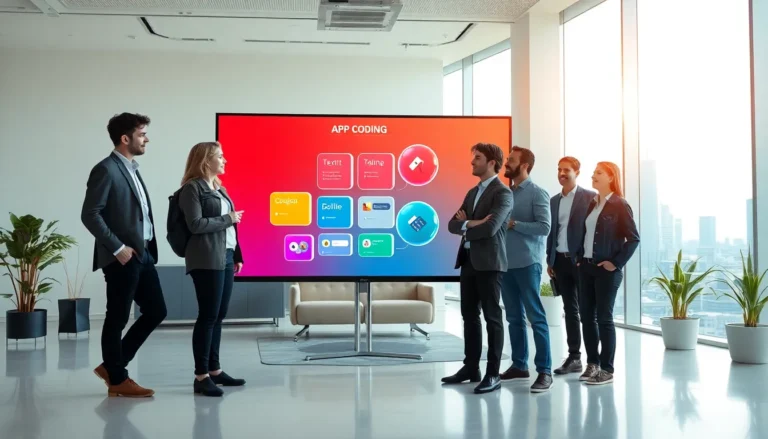In today’s fast-paced digital landscape, agencies are constantly seeking ways to streamline their processes and enhance productivity. No-code platforms have emerged as a game-changer, empowering teams to build and deploy applications without the need for extensive coding knowledge. This shift allows digital agencies to focus on creativity and strategy rather than getting bogged down in technical details.
With no-code tools, agencies can quickly prototype solutions, automate workflows, and deliver projects faster than ever. This not only improves client satisfaction but also opens up new avenues for innovation. As the demand for agile solutions grows, understanding how to leverage no-code technology becomes essential for agencies aiming to stay competitive in a rapidly evolving market.
Table of Contents
ToggleUnderstanding No-Code for Digital Agencies
No-code platforms empower digital agencies to develop applications and automate processes without requiring substantial programming skills. This capability enhances agility and creativity, allowing teams to shift focus toward strategic initiatives.
Definition of No-Code
No-code refers to software development platforms that permit users to create applications through visual interfaces, rather than traditional coding. Users employ drag-and-drop functionalities and pre-built templates to build projects. No-code tools cater to users at all skill levels, offering an accessible route for digital agencies to harness technology without having deep technical knowledge. Popular no-code platforms include Webflow, Bubble, and Airtable.
Importance of No-Code in Digital Agencies
No-code solutions present numerous advantages for digital agencies:
- Efficiency: No-code tools accelerate the development process, enabling quicker project launches and faster iteration. This speed enhances service delivery timelines.
- Cost-Effectiveness: By reducing reliance on specialized developers, agencies can cut labor costs and allocate resources more strategically. This approach allows for better budgeting in client projects.
- Innovation: No-code platforms foster a culture of experimentation, enabling teams to create prototypes rapidly. This capability encourages innovative solutions and creative problem-solving.
- Collaboration: Non-technical team members can contribute to the development process, promoting collaboration between designers, marketers, and developers. This synergy leads to comprehensive project outcomes.
- Scalability: As digital demands grow, no-code platforms can scale easily. Agencies can modify applications and workflows to adapt to evolving client needs without extensive re-engineering.
Embracing no-code technology strengthens digital agencies’ competitiveness, enabling them to navigate a rapidly changing market and deliver high-quality results.
Benefits of No-Code Solutions

No-code solutions offer significant advantages for digital agencies, enhancing their operations in multiple areas. These tools streamline processes, reduce costs, and foster better collaboration among team members.
Increased Efficiency
Increased efficiency arises from simplified development processes. No-code platforms empower teams to build applications rapidly through visual interfaces. Users can create prototypes in hours, not weeks, enabling faster iterations. By automating recurring tasks, agencies reduce manual work, allowing staff to focus on strategic initiatives. Improved workflow optimizes resource allocation, resulting in timely project delivery.
Cost-Effectiveness
Cost-effectiveness stems from reduced development expenditures. Agencies save on hiring specialized developers as no-code tools require minimal technical expertise. Lower overhead costs associated with project timelines enhance agency profitability. By minimizing the need for extensive coding knowledge, teams can leverage existing staff, further cutting costs. Substantial savings on technology infrastructure enhance overall financial flexibility.
Enhanced Collaboration
Enhanced collaboration promotes productive teamwork. No-code solutions facilitate real-time feedback and iteration between team members. By using a common visual language, everyone can contribute regardless of technical proficiency. This level of inclusivity streamlines communication, resulting in fewer misunderstandings. Improved alignment among stakeholders aligns projects more closely with client expectations, ensuring a higher level of satisfaction.
Popular No-Code Tools for Digital Agencies
Digital agencies can leverage various no-code tools to enhance their operations, streamline processes, and deliver projects efficiently. The following categories provide insight into some of the most popular no-code tools available.
Website Development Platforms
- Wix: Offers intuitive drag-and-drop functionality, enabling users to create visually appealing websites quickly.
- Squarespace: Provides designed templates with built-in tools for e-commerce and blogging, facilitating easy customization.
- Webflow: Combines visual design and CMS capabilities, allowing for responsive websites without extensive coding.
- Bubble: Allows users to design, develop, and host applications, making it suitable for building complex web applications.
Automation Tools
- Zapier: Connects different apps to automate repetitive tasks, saving time and enhancing productivity across workflows.
- Integromat (Make): Automates processes between multiple services, enabling users to build intricate workflows with conditional logic.
- Parabola: Offers data integration and automation tools for managing and processing data without programming knowledge.
- Automate.io: Provides integration solutions for various apps, helping users automate tasks between them through a simple interface.
Database and Integration Solutions
- Airtable: Combines spreadsheet functionalities with database capabilities, allowing teams to manage projects and collaborate efficiently.
- Google Sheets: Serves as a flexible database for data management and integration, compatible with numerous applications and tools.
- Notion: Functions as a database and project management tool, promoting collaboration and information sharing within teams.
- Figma: While primarily a design tool, it integrates with various platforms, streamlining design processes and project handoff.
Utilizing these no-code tools empowers digital agencies to optimize their operations, maintain competitiveness, and deliver exceptional results for clients.
Challenges of Implementing No-Code
Digital agencies face several challenges when implementing no-code solutions. These challenges can impact project outcomes and overall agency efficiency.
Limited Customization
No-code platforms often provide pre-designed templates and functionalities, limiting customization options. While these features simplify the development process, they may not meet the unique needs of every client. Agencies may find it difficult to implement specific branding elements or advanced functionalities. Customizable features can sometimes involve complex workarounds, delaying project timelines and requiring additional resources.
Learning Curve for Teams
Teams may encounter learning curves when adopting no-code tools. Not all team members will possess the same level of technical proficiency or adaptability to new technologies. Adjusting to visual development methods may take time, impacting productivity during the transition phase. A lack of comprehensive training or support resources can exacerbate these challenges, leading to frustration and inefficiency within teams.
Case Studies of No-Code in Action
Analyzing real-world applications of no-code solutions showcases their transformative impact on digital agencies. These case studies reveal effective strategies and insights gained from implementation.
Agency Success Stories
- Agency A’s Rapid Prototyping
Agency A utilized Webflow to develop multiple landing pages for diverse clients in under a week. This accelerated prototyping enabled faster client feedback and iterative improvements, enhancing client satisfaction.
- Agency B’s Workflow Automation
Agency B adopted Zapier to automate their lead generation process. This integration reduced the time spent on manual tasks by 70%, streamlining operations, and allowing the team to focus on strategic initiatives.
- Agency C’s Custom Solutions
Agency C leveraged Airtable for project management, allowing them to customize workflows without extensive coding. This adaptability led to improved team collaboration and optimized resource allocation, increasing project delivery speed.
Lessons Learned from No-Code Adoption
- Emphasizing Training
Successful agencies prioritize comprehensive training programs for team members. This investment in skill development minimizes the learning curve and enhances overall productivity.
- Ensuring Client Involvement
Agencies find that maintaining client engagement throughout the development process results in better-aligned outcomes. Regular feedback loops foster innovation and enhance client relationships.
- Balancing Customization and Efficiency
Agencies often adjust their approach to customization by blending no-code solutions with traditional development methods. This hybrid model addresses unique client needs while benefiting from the efficiency of no-code tools.
No-code platforms are revolutionizing the way digital agencies operate. By streamlining development processes and enhancing collaboration, these tools empower teams to focus on creativity and strategic initiatives. The ability to quickly prototype and automate workflows leads to increased efficiency and improved client satisfaction.
While challenges exist, such as limited customization and potential learning curves, the benefits far outweigh the drawbacks. Agencies that embrace no-code technology position themselves for success in a competitive landscape. As they adapt and innovate, the future of digital agencies looks promising, with no-code solutions at the forefront of their evolution.










